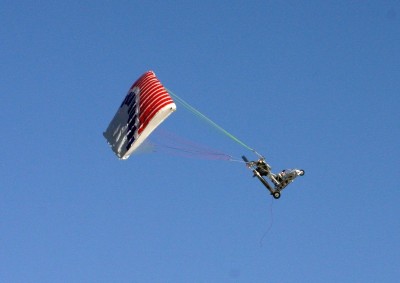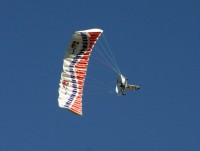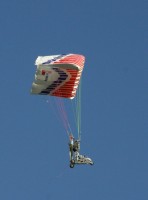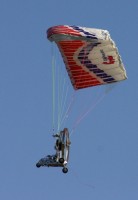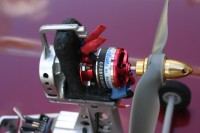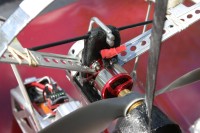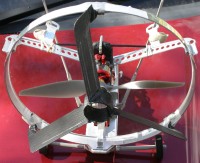The Cyber Parachute Surfer.
Page
two.
Upgrading the Cyber-chute.
April 2007,
This page is pitched at the RC novice. Experienced RCers may already have the gear and hopefully the know-how.
This is an Australian site, prices mentioned are either Aussie or US depending on where I found stuff.
Currently one AU$ = US$0.81 , prices are just a guide so it doesn't matter too much.
As I stated on
page one – a well designed, well tuned paraplane could be
the perfect RC model for beginners – unfortunately the cyber
chute has it's failings.
Out of the box you are likely
(probably certain) to have one of two problems and possibly
both.
The first is inadequate motor power (and duration).
Some will climb using the stock battery but mine didn't. The
clones are supplied with nicad batteries which are very 'last
century' technology. You can expect about four minutes flight
duration.
The second
problem is a sever roll to the right. The more power you have the
worse this gets. If you have inadequate power for climb the roll
problem is less sever.
My transmitter didn't have adequate yaw
(rudder) trim to compensate. If you do manage to launch and trim
it - the model will go left once you reduce power. This is not
good for a beginner to manage.
Refitting any RC model is expensive, if it is the first one you're doing. The second one is much cheaper because you already have the transmitter, charger and parts you can borrow from earlier models. With only a motor and one servo the cyber-chute refit is likely to be cheaper than any most powered RC aircraft.
There are budget parts available, they are usually a bit heavier but if they work properly could be quite good value.
Battery.
The cheapest (but
not cheap) and easiest improvement you can make is to put in a
decent battery. Even nickel-metal-hydride batteries (twice the
capacity of ni-cad) are pretty much obsolete and hard to find.
Genuine sky-surfers had an optional 1100 mAH NiMH pack but I doubt
you can buy one now.
Everybody uses Lithium polymer (LiPo)
these days. They aren't cheap but the prices are coming down.
These model don't fly well if you reduce the weight so ideally you
want a LiPo which is about the same weight as the original - that
means around 2200 mAH and 7.4 volts. A good quality battery will
set you back US$60 or so but you can get a budget model for $20. I
have no idea how good the cheap ones are. A charger will cost more
than that. Mine (a swallow) was $100AU you can possibly get
sometime for half that. You should also get a balancer (already
built in to some charges). Many chargers (like mine) run off
12Volts so you need a decent 12V supply to drive them (eg a car).
A good battery will probably fix problem the power and duration
problems.
There is a catch here – the battery for a
stock model need to be around 7.2V so you can only use two cell
LiPo (7.4).
The problem is if you decide do a complete upgrade
you may want to use a 11V battery, most people do.
The Chute.
The clone chutes are not particularly well made. Fortunately they fly better and last longer than you might expect. There are currently no alternatives that I know of. Genuine sky-surfer canopies are no longer available in most parts of the world. I think I got the last two to leave Japan. I have experimented with using kites but they won't fly well on a stock model. It is possible a kite can be made to work with a fully upgraded model - it is research in progress. Kites have more drag than the plastic sky-surfer chute so performance will be reduced. This is offset by the convenience of a cloth chute which can be folded and does not require spreaders – stay tuned for kite progress.
The sky-surfers
use a plastic chute compared by some to shopping bags. The rigging
is unusual. Most paraplane foils I've seen have four rows of lines
which terminate at two attachment points. Typically one group of
four lines is attached to every second rib.
Parafoil kites
usually seem to have three rows.
The plastic chute
only has two rows. One set at the front and the other about one
third back from the trailing edge.
All other chutes I've seen
are cloth only. The surfer chute alone uses soft foam ribs and
plastic tubes spreaders (AKA stiffeners) – this allows them
to work with only two rows and allows for a thinner lower drag
profile.
The lines terminate to four attachment points not two.
You can easily
convert a surfer to use a two line chute and you can also convert
a surfer chute to work on a two line model.
You can also do
both and fly a surfer chute on a surfer in two string mode. This
changes the flying characteristic.
I should also
mention the canopy area has to be matched to the weight. A bigger
chute is not going to work nor is dramatically reducing the weight
of the stock model.
When the load on the chute is too little
the gondola becomes unstable. This is mainly when powered –
models which are unstable during powered flight will often fly
quite well in the glide. They will also fly better when turning
because the line tension increases.
The full upgrade.
Other items you
may want to upgrade are – the radio receiver, the servo, the
ESC (speed controller) the motor and propeller. The bad news is
you pretty much have to do them all together. Everything in the
stock model is non-standard, probably the RF signal is also
non-standard – it is 27mhz which is illegal in many
countries.
The receiver, ESC and the servo electronic are on
one board. You really have to throw this away and replace it with
standard RC parts.
Another hack which has been done is to add an extra control channel (and servo) to alter the AOA (angle of attack) of the chute in flight.
The radio.
I usually use JR
gear for it's long range but it is expensive. Budget receivers
(RX) can be as low as $20Aus but quality and compatibility are
unknown to me. Remember control failure could result in the loss
of the model (upgraded and now worth hundreds of dollar), so it
might be worth a few extra dollars for a known brand. I've used
GWS ($32 for 6-channel) with no problems.
You only need two
channels to fly the cyber-chute but you're unlikely to find
anything less that a four channel RX.
A common fantasy which
seems to be shared by most of us - is to fit the model with a
camera – some extra RC channels are handy for this.
Most
FM RXs and transmitters (TXs) are compatible. JR, GWS and futaba
will all work together but some may need channels reversed.
I
have a basic JR 6 channel TX which works fine but I had to hack it
the move the throttle to the left where I wanted it.
Forcing
ozi pilots to use a different configuration to the US is a major
gripe of mine.
If you have a helicopter style remote this could
be handy because of the built in fixing functions – these
may be able to compensate for torque steering (ie the roll
problem). I don't have one to try it. There are also separate heli
tail mixers that might work. I have one but I'm not planning on
trying it.
The motor.
It is not essential to replace the motor but pretty much everyone does. Brushless motors are lighter, more efficient and some have enough torque for direct drive. On the other hand keeping the motor lets you use a cheaper ESC and lets you use any two cell LiPo you may have bought for it.
The most promising fix for the roll problem mentioned early is mount the motor so the thrust is off axis by about four degrees. This is hard to do if you keep the gearbox so direct drive brushless make a lot of sense.
Choosing the correct motor is difficult. You need to match the speed (RMP per volt) and have enough power. For direct drive you will need an “outrunner” type motor. AXI is one popular brand, there seem to be cheap motors about ($15) but I don't know how well they work.
My preferred motor is a CDROM style
motor. These don't actually come from CDROM drives any more but
use a similar design. I have taken to winding my own.
A single
stator CDROM motor should work fine.
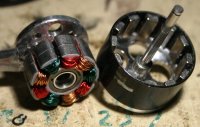 gobrushless.com
has kits starting at US$9 but a decent kit
with ball bearings and firewall mount is US$26.49. For a few extra
dollars you can get a double stator kit. You shouldn't need a
double but if you have room the bigger motor should run a bit
cooler and possibly more efficiently. I'm using a single for size
reasons.
gobrushless.com
has kits starting at US$9 but a decent kit
with ball bearings and firewall mount is US$26.49. For a few extra
dollars you can get a double stator kit. You shouldn't need a
double but if you have room the bigger motor should run a bit
cooler and possibly more efficiently. I'm using a single for size
reasons.
Making a motor sounds daunting but it isn't so bad
after the first one. The hard part is working out how many turns
to use but I've got some numbers that seem to work which I've
shared (see black rainbow page
two).
The motor shown here is a double stator motor built
from a kit. Winding your own not only lets you choose the number
of turns used but also lets you choose between a star (AKA wye or
Y) or delta winding. Most commercial motors are star wound most
high performance CDROM motors are delta. Both styles work but the
number of turns are different.
Propeller.
You can use the stock prop if you want but I didn't. There are three reasons why I changed.
The prop has the reverse pitch to the common props sold at my local hobby shop. This means either it rolls right while my other models roll left or I offset the motor to compensate. Which side you offset it depends on rotation direction. If I offset it and need to replace the prop I will have to match the pitch or move the motor again to the other side.
I can swap props between models.
I have spinners which fit the motors I use – these would not fit the stock prop without modification.
The props I use aren't specially made to be pushers, you just mount them on the spinner to be a pusher. You might be able to find a push-on pusher prop that will fit but using a common prop has a lot going for it.
I'd suggest you match the stock size and pitch if you can unless you have a good reason to change it. Presumably the original designer/builder found this to be the best.
The genuine
sky-surfer prop is part number HBZ78118 and is a 9*4 inch prop.
That is nine inch diameter and a travel of four inches per rev
(less in practice)
I couldn't get 9*4 so I'm using 9*4.5 and
also have a 9*3.8 I haven't tried. If you're flying faster (heavy
or with canopy adjusted for speed) a courser pitch should work
better.
If you measure static thrust you'll find a fine
pitch will give you more thrust. Don't be fooled into thinking
this is necessarily better. It is like gears in a car – a
low gear gives more starting torque but won't go fast.
ESC.
Your motor needs
an “electronic speed controller”. Brushed and
brushless motors generally use different controllers though there
are a few ESCs which can do both. Brushed ESCs are cheaper and
often simpler. I've used JETI brushed controllers and phoenix
brushless. Phoenix are good but once again not cheap.
I have
ordered an eWatts Brushless 18A to try out – at AU$24
it is a fraction of the price of a phoenix – this will be
tested on the my new black flying thing.
Most ESCs will have some way to
configure them. The phoenix ESC can be programmed using the radio
TX or with a USB interface – I do the former.
A whole
lots of parameters can be set this way. Things like timing, brake
settings, current limits etc.
One very important setting is the
cut out voltage. You don't want to run your battery flat because
you will loose not only motor power but control power.
If you
are using LiPo running them flat will ruin them. To avoid this
happening the ESC senses the input voltage and when it gets low it
cuts power to the motor.
You may have to set the cut out
voltage to suit your battery, some ESCs guess the number for you.
The most obvious difference between controllers is there current rating. I'm putting a phoenix-10 (10 amp) into my surfer – this should be enough unless I want to add a lot a weight.
BEC.
This stand for “battery eliminator circuit”. This might sound strange for something battery powered but it makes sense in that some older RC gear used a separate battery. Ie one for motor, one for radio and servos. All a BEC is is a five voltage regulator (sometimes six volt). All modern ESCs have a BEC built in. Some even have two – one for the motor controller on one for everything else – mainly to reduce RF interference.
In most electric RC aircraft you attach the battery to the ESC, when you plug the ESC into the radio BEC power (5V) is fed to the radio which then routes power to the servos which are plugged into it.
The ESC/BEC is a
crude linear regulator, they are inefficient – particularly
with higher battery voltages. A separate switched mode (efficient)
BEC can be used if required. A park-BEC is one I've used before.
If you are just going to run the steering servo you probably
wouldn't bother.
Your ESC instructions should give some guide
to how much load you can hang off the BEC at different battery
voltages. If you plan to use extra servos you may need a separate
BEC.
Servo.
The entire weight
of the gondola hangs off the servo. When I built my black
rainbow I agonized over torque and side load and bought
a fast, grunty, dual bearing hitech servo. It turns out the servo
doesn't have to be fancy. A basic futaba 3003 is one type which is
known to work.
I was planning on using the hitech in the surfer
but found that the spline on the servo was too small to fit the
servo arm – the futaba spline fits.
Ted's Hack.
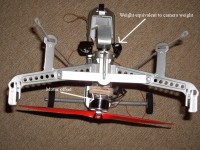 I
didn't hold out much hope that there would be an easy fix for the
torque steering problem. Strangely only people with surfer clones
are reporting this problem so it appeared like it might be that
small paraplane flyers would have to live with it.
I
didn't hold out much hope that there would be an easy fix for the
torque steering problem. Strangely only people with surfer clones
are reporting this problem so it appeared like it might be that
small paraplane flyers would have to live with it.
Fortunately
Ted Robinson (who is in our paraplane google group) tried skewing
the motor off axis to compensate. I did not think this would work
but apparently it does. This could potentially solves a serious
control problem and could allow us to fly lighter and also to use
kites. Ted's test mod is shown here. You don't need to be hi-tech
to contribute to the knowledge base.
If you're interested in this stuff you should join the group.
Fred's Hacks
Fred Garvey posted some notes to the group which I have copied here. Fred has informed me that he hit a snag in that his motors have been burning out rapidly. He puts this down to reversing the polarity to make them spin the other way. (The stock motors did strike me as being a bit small for the job.)
My Hack 1.
Easter
2007.
After sitting on the shelf for almost a year the cyber
chute flew again – briefly. It flew for perhaps a minute
then lost revs and descended. I'm not sure why it was different to
last time but it was. I decided it was time to rebuild it. Seeing
the electronics were going in the bin I experimented with running
it on three LiPo cells (11V).
It had lots of power for a second
or so then the a fin pulled out of it's joiner and the prop struck
plastic breaking the cross bar.
After that the motor didn't work properly any more.
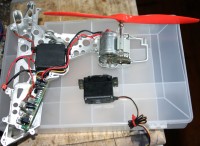 So
lets see what we have here.
So
lets see what we have here.
Like most cheap RC toys
there isn't really much worth keeping apart from the frame. Some
people reuse the propeller but I'm not. Even fewer use the
reduction gear. The servo is non-standard, it has no internal
electronics and is useless. I'm re-using the servo arm but the
spline did not match the hi-tech servo I planned to use so I
bought a futaba instead. The electronic s(RC receiver etc) is also
useless.
Note the prop shaft passing through the middle of the joiner which hold the fins. This means you can't put a direct drive motor in the logical position unless you modify the fins.
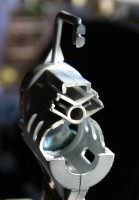 I
chose to locate a small CDRom motor behind the joiner. Here I've
ground away all the plastic where the motor will go. The motor is
recycled from my black rainbow
project. The joiner was later secured using a rawl plug up the
middle and a plaster-board screw.
I
chose to locate a small CDRom motor behind the joiner. Here I've
ground away all the plastic where the motor will go. The motor is
recycled from my black rainbow
project. The joiner was later secured using a rawl plug up the
middle and a plaster-board screw.
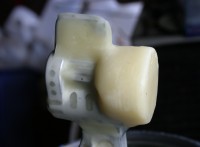 The
cavity was filled with tissue and the motor tube repeatedly dipped
in wax to build up a large blob which was then shaped using hot
cloths iron, a cheese grater and any suitable carving tool that
came to hand. When I had the desired shape, it was again hot
dipped to completely cover the work area (and the floor) with a
release layer to prevent epoxy touching the plastic.
The
cavity was filled with tissue and the motor tube repeatedly dipped
in wax to build up a large blob which was then shaped using hot
cloths iron, a cheese grater and any suitable carving tool that
came to hand. When I had the desired shape, it was again hot
dipped to completely cover the work area (and the floor) with a
release layer to prevent epoxy touching the plastic.
The wax plug was made strong enough to prevent being crushed when placed under vacuum.
 Carbon
fibre cloth was wrapped around the plug and held in place with
sewing thread till in was vacuum
infused with epoxy resin. This was the quickest infusion I've
even done.
Carbon
fibre cloth was wrapped around the plug and held in place with
sewing thread till in was vacuum
infused with epoxy resin. This was the quickest infusion I've
even done.
Once the resin had cured the wax was melted out and
the carbon fibre housing trimmed to size, mounting holes drill
then ventilation holes added. The housing weighs 16 grams and is
very strong. The motor is skewed about four degrees (CCW when
viewed from top) to reduce torque steering problems.
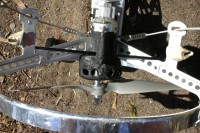 The
broken cross-bar is being replaced by a 3mm carbon rod which locks
the housing in position. When the bench testing is complete it
will be bound in place with cotton and CA – strong but
removable when the need arises.
The
broken cross-bar is being replaced by a 3mm carbon rod which locks
the housing in position. When the bench testing is complete it
will be bound in place with cotton and CA – strong but
removable when the need arises.
By the way the strange lumps of putty are for flying a two string canopy – the servo extenders are moved back into these holes so they are closer to the COG (centre of gravity).
April 27.
I've had a lot of trouble getting my single stator CDROM motor to work. I replaced the magnets and rewound it several times. It is now delta wound with 26 turns of 28 gauge wire per pole. It works but it is still getting very hot. The double stator motor I made for the rainbow (and now in the black thing) runs cool. I think I will be moving to double and triple stator motors in future.
Anyway it flew. It launch and climbed well
on the first attempt but the steering was terrible. My
cyber-chutes are both pretty sluggish.
The climb out was very steep and looked semi-stalled. It flew level on less than ½ throttle.
My setup was
Servo futaba 3003
Motor direct drive go-brushless single stator cdrom.
ESC pheonix-10
RX – 4 channel GWS
Prop 9*4 inch
Battery - three cell lipo - 1800mAH flightpower EVO-20 (11.1V)
Gondola 480 grams (very close to stock weight).
The canopy was set for maximum AOA – this may have a bearing on the steering problem. The old cyber-chute canopy flew fine on the black rainbow gondola when converted to two string mode. It may be worth flying it on the cyber-chute in two string mode to see how it steers. It may also be worth adding some weight or using a stiffer servo arm.
I'm not sure if I will be doing any more on this.
The flight showed the offset motor does work – the model did
not torque roll as it used to.
The black
thing is almost ready to fly so I will be focusing on that.
If anyone is interested in working with carbon like I do – buying a cyber-chute and replacing parts with custom carbon one piece at a time would be a way to get into it without having to make everything in one go. If you replace the shroud with carbon you could probably increase the prop size to 10 inch for extra thrust.
If I did this again I think I'd totally replace the motor tube. It would mean changing the central fin attachment but would be easier overall.
May Day 2007.
Thanks to Len Martin for taking these photos.
I did some more test
flights at Nimbin where I have more space. All launches were
successful but the flights were fairly short because the motor is
still getting very hot – too hot for me to hold my finger on
the mounting screws after landing.
Full power climbs were very
steep and stable. It again gave the impression of climbing
vertically, I don't think it was but it looked that way from
behind.
The steering problem is only when turning left. Right
turns and level are fine but left is extremely slow.
It appears the motor offset is about right when using full power but to much on a cruise setting.
I'm also now convinced the giggling/shimmying motion of the gondola in this and other models is a gyroscopic precession problem from the spinning prop. A lighter (carbon) prop would help here.
My Hack 2.
Cheers Eddie.M.
